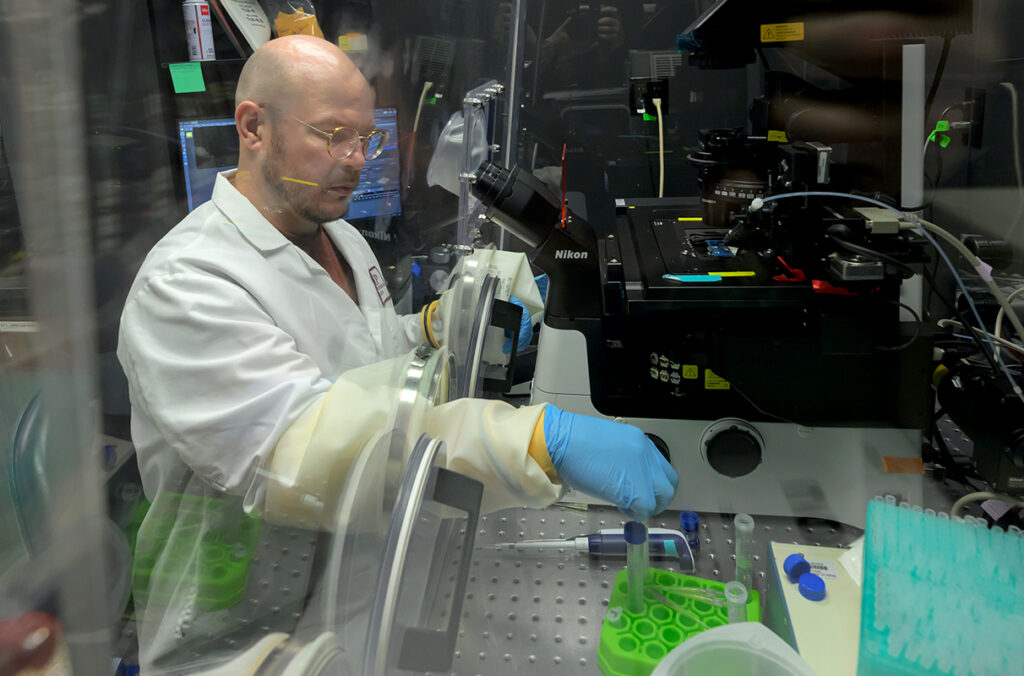Health
Bacteria Navigate Gut Risks for Nutrients, New Study Reveals

Research from the Baylink Lab at Washington State University has unveiled how disease-causing bacteria, such as Salmonella, can navigate hostile environments in the human gut to seek out nutrients, even when faced with harmful chemicals. The study, published in the journal eLife, demonstrates that these bacteria may swim towards a stinky chemical called indole, typically avoided due to its potential to kill them at higher concentrations.
Arden Baylink, an assistant professor leading the research, likens the bacteria’s decision-making process to a person searching for food in a crowded, unpleasant setting. “Imagine you’ve made a long journey and you’re starving,” he said. “You look for a place to eat, only to find it crowded with others and a line out the door.” This dilemma highlights the challenges that pathogenic bacteria face as they traverse the human digestive tract.
Indole, a chemical produced by beneficial gut microbiota, contributes to the characteristic odor of feces. While this substance can be lethal to infectious bacteria at elevated levels, the Baylink Lab’s research reveals that when combined with nutrients, the dynamics change significantly.
Using a custom-built microscope, Baylink and doctoral candidate Kailie Franco observed the behavior of various bacteria. They found that while pure indole repels Salmonella, the presence of nutrients alters this response. “At first, we saw what others had seen. Salmonella swims away from pure indole, no question, and really fast. Within 10 seconds, the bacteria are gone,” Baylink explained. However, when nutrients are present alongside indole, the bacteria demonstrated an attraction despite the chemical’s potential dangers.
The degree of attraction varied depending on the concentration of indole. Lower levels of indole resulted in a stronger attraction to the nutrients. Even at high concentrations of indole, bacteria were still somewhat drawn to the nutrient source. This pattern was consistent across multiple pathogens, including different types of Escherichia coli, Citrobacter koseri, and Enterobacter cloacae, all of which can cause serious intestinal infections and pose increasing challenges due to antibiotic resistance.
The team also explored whether indole could prevent Salmonella from infecting intestinal tissue but found no evidence to support this. Instead, the study suggests a new perspective on bacterial behavior in the gut. Indole serves as a signal, guiding bacteria toward areas with less competition and abundant nutrients. “Indole tells them where their competition, the microbiota, is located,” Baylink noted.
This research, funded by the National Institutes of Health (NIH) through its National Institute of Allergy and Infectious Diseases, included collaborations with scientists at the University of Oregon. Findings from this study may pave the way for new treatments targeting drug-resistant bacterial infections and sepsis by disrupting how bacteria sense their environment.
Baylink expressed gratitude for the public support that enables such research: “We’re grateful to the taxpayers who support our research so we can advance our understanding of bacterial diseases and develop new treatments.” The implications of this work could be significant in the ongoing battle against antibiotic resistance and the quest for effective therapies.
-

 Technology5 months ago
Technology5 months agoDiscover the Top 10 Calorie Counting Apps of 2025
-

 Technology2 weeks ago
Technology2 weeks agoOpenAI to Implement Age Verification for ChatGPT by December 2025
-

 Health3 months ago
Health3 months agoBella Hadid Shares Health Update After Treatment for Lyme Disease
-

 Health3 months ago
Health3 months agoAnalysts Project Stronger Growth for Apple’s iPhone 17 Lineup
-

 Health3 months ago
Health3 months agoErin Bates Shares Recovery Update Following Sepsis Complications
-

 Technology5 months ago
Technology5 months agoDiscover How to Reverse Image Search Using ChatGPT Effortlessly
-

 Technology3 months ago
Technology3 months agoElectric Moto Influencer Surronster Arrested in Tijuana
-

 Technology2 months ago
Technology2 months agoDiscover 2025’s Top GPUs for Exceptional 4K Gaming Performance
-

 Technology5 months ago
Technology5 months agoMeta Initiates $60B AI Data Center Expansion, Starting in Ohio
-

 Technology5 months ago
Technology5 months agoRecovering a Suspended TikTok Account: A Step-by-Step Guide
-

 Health5 months ago
Health5 months agoTested: Rab Firewall Mountain Jacket Survives Harsh Conditions
-

 Lifestyle5 months ago
Lifestyle5 months agoBelton Family Reunites After Daughter Survives Hill Country Floods













